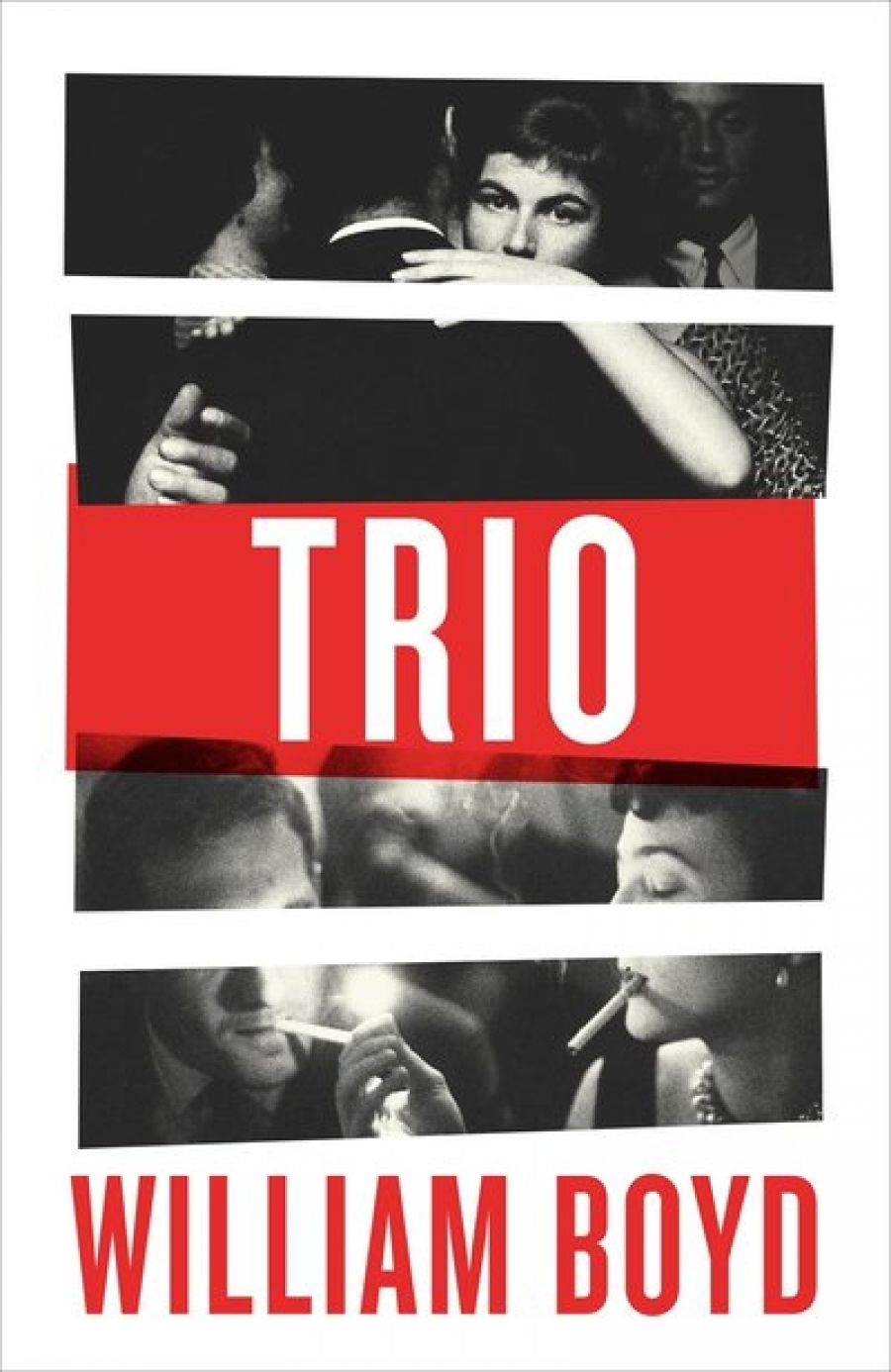
- Free Article: No
- Contents Category: Fiction
- Review Article: Yes
- Custom Highlight Text:
The first three chapters of William Boyd’s beguiling new novel, Trio, are devoted to the waking habits of three people: a novelist called Elfrida Wing, stirred from slumber by the brightening morning sun; a film producer called Talbot Kydd, jolted into a new day by an erotic dream taking place on a beach; and an American actress called Anny Viklund, who, it seems, hasn’t had the time to consider sunrays or reverie. Anny, the only one of the trio not to wake up alone, has spent a vigorous night with a younger man called Troy Blaze.
- Grid Image (300px * 250px):

- Book 1 Title: Trio
- Book 1 Biblio: Viking, $32.99 pb, 352 pp
- Book 1 Readings Link: booktopia.kh4ffx.net/PL00N
That prolix title alone ought to give away the fact that Trio is not a novel of our times, but one of more than half a century ago. This was in 1968, when England basked in the lurid glare of psychedelia, made movies actually titled Can Heironymus Merkin Ever Forget Mercy Humppe and Find True Happiness?, and tried (like the ageing Talbot) to fathom the meaning of the line ‘Someone left the cake out in the rain’ from Jimmy Webb’s song ‘MacArthur Park’.
Anny Viklund plays Emily B, and her paramour, Troy, is her leading man. It almost goes without saying that most of their scenes involve a banana-yellow Mini. Anny also has a dark side, in the form of two other men: Jacques Soldat, a philosopher boyfriend in Paris, and Cornell Weekes, her former husband, a terrorist on the run from Special Branch and the FBI, who appears on the scene, demanding money.
Talbot Kydd, a war veteran with a wife in London and two grown children, is the movie’s long-suffering producer, who, in true sixties fashion, nurses an ulcer and, as we soon discover, is on the verge of easing open the door of the closet in this, the early, tentative period following the legalisation of homosexuality in England. But Talbot also has a crisis a day to manage, not merely with the film but with the corporate machinations of the company making it.
More peripherally involved with the film is Elfrida Wing, who is married to its director, Reggie Tipton, a serial philanderer, who insists, for professional reasons, on being called Rodrigo. Elfrida, lodging in Brighton with nothing in particular to do except drink to excess, is fed up with being called ‘the new Virginia Woolf’, and personally blames the old one for an extended bout of writer’s block. How ironic, then, that VW (as if from the depths of the Ouse river) provides the very literary inspiration for Elfrida’s new novel?
Trio yields its various secrets carefully, not entirely predictably, and occasionally with surprising, even dramatic, results. But this is essentially an intimate, chamber-like work, and the very opposite of the more symphonic scope of Love Is Blind, Boyd’s 2018 novel about a Scottish piano tuner in fin-de-siècle Scotland, France, and Russia.
Boyd, always a fine storyteller, conveys his sharp sense of social observation of an era that seems as alien to many of us now as the Roaring Twenties would have been to Screaming Lord Sutch or Jane Asher. Mind you, Boyd’s recollections were possibly aided by the likes of Joan Collins and Frederic Raphael, who are included in a list of gratitude and acknowledgments.
My problem with Trio is more to do with other characters, some of whom seem to exist for momentary reasons rather than to advance the plot. Take the appearance of a distinguished local actor, Sir Dorian Villiers, whose rococo speech habits owe much to an actual knighted thespian who lived in Brighton, Laurence Olivier. At a swanky at-home party (Dirk Bogarde and Jill Bennett are in attendance), Villiers taps Talbot for a cameo role in the film. But, I suspect, this episode was really more of a dramatic device to place the three main characters in the same room.
Not that Elfrida, Anny, and Talbot meet up all that often. It’s their separate lives – for which also read parallel universes – that matter here more than any personal or professional cohesion. When there is an encounter it is almost incidental – but shrewdly observational, too. For example, Anny, who can’t quite remember Talbot’s name, recalls him only as ‘tall and bald’ with ‘one of those classic, clipped, dry English accents’. Or, conversely, Talbot sees in Anny ‘an exceptionally tiny person … as if she were a prototype or a maquette for a young woman, almost a different species’. Or, when Talbot encounters Elfrida in a bar, he regards her as ‘the oddest woman … Tall, slim, she seemed to be trying to hide her face behind her thick dark hair ... She often wore heavy black-rimmed spectacles that made the barrier seem even more impenetrable, though, oddly again, her lips were always painted a lurid red.’
In its abrupt, episodic way, Trio propels one along, but mainly out of entertainment value rather than anything more profound or lasting. To me, it reads as if it is more of a treatment for its own film version or, possibly, a six-parter for BBC television. Can’t you see that banana-yellow Mini hurtling over the cliff at Beachy Head?


Comments powered by CComment